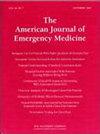Neonatal presentations in the pediatric emergency department: A decade-long retrospective analysis
IF 2.7
3区 医学
Q1 EMERGENCY MEDICINE
引用次数: 0
Abstract
Background
The global increase in neonatal visits to Pediatric Emergency Departments (PEDs) underscores the need to better understand the factors driving these visits and their implications. The often vague and nonspecific symptoms of neonates pose significant challenges for clinicians and caregivers in determining the appropriate level of care, impacting the frequency of return visits and overall effectiveness of discharge education.
Objective
This study aims to compile the most common chief complaints of neonates in the PED and analyze their association with admission rates and final ED diagnoses to inform educational interventions for caregivers and medical personnel.
Methods
This was a retrospective review of data from medical records from neonatal (≤30 days of life) presentations to the PED at a quaternary care medical center in Portland, Oregon, USA from January 2012 to December 2022.
Results
3175 patient encounters were identified, of which one-third (38 %) were admitted to the hospital. Certain complaints had higher admission rates than the average: temperature instability (71 % for “fever” and 89 % for “hypothermia”), breast concerns (68 %), abnormal lab results (63 %), “seizures” (53 %), and cardiac concerns (54 %). Notably, neonates presented on DOL 0 and DOL 1 had elevated admission rates of 77 % and 66 %, respectively.
Conclusion
This study identified specific complaints that were most likely to result in hospital admissions and return visits to the ED. This can guide targeted educational interventions for caregivers and ED providers and refinement of triage protocols to ensure that neonates receive the most appropriate and efficient care.
儿科急诊中的新生儿病例:长达十年的回顾性分析
背景儿科急诊室(PED)的新生儿就诊人数在全球范围内不断增加,这凸显了更好地了解这些就诊因素及其影响的必要性。新生儿的症状往往含糊不清且没有特异性,这给临床医生和护理人员确定适当的护理级别带来了巨大挑战,影响了回访频率和出院教育的整体效果。本研究旨在整理儿科急诊科新生儿最常见的主诉,分析其与入院率和最终急诊科诊断的关联,为护理人员和医务人员的教育干预提供参考。方法这是对美国俄勒冈州波特兰市一家四级医疗中心2012年1月至2022年12月期间新生儿(出生≤30天)到急诊科就诊的病历数据进行的回顾性分析。某些主诉的入院率高于平均水平:体温不稳定("发烧 "占 71%,"体温过低 "占 89%)、乳房问题(68%)、化验结果异常(63%)、"癫痫发作"(53%)和心脏问题(54%)。值得注意的是,在 DOL 0 和 DOL 1 出现的新生儿入院率分别为 77% 和 66%。这可以指导护理人员和急诊室提供者采取有针对性的教育干预措施,并改进分诊方案,以确保新生儿得到最适当、最有效的护理。
本文章由计算机程序翻译,如有差异,请以英文原文为准。
求助全文
约1分钟内获得全文
求助全文
来源期刊
CiteScore
6.00
自引率
5.60%
发文量
730
审稿时长
42 days
期刊介绍:
A distinctive blend of practicality and scholarliness makes the American Journal of Emergency Medicine a key source for information on emergency medical care. Covering all activities concerned with emergency medicine, it is the journal to turn to for information to help increase the ability to understand, recognize and treat emergency conditions. Issues contain clinical articles, case reports, review articles, editorials, international notes, book reviews and more.

 求助内容:
求助内容: 应助结果提醒方式:
应助结果提醒方式:


